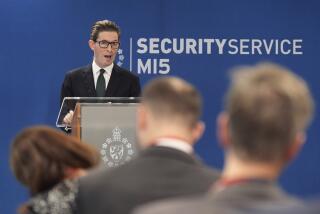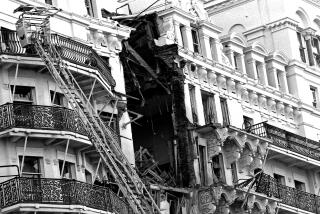British Officials Fear IRA May Be Ready for New Offensive
- Share via
LONDON — A recent flurry of activity by the outlawed Irish Republican Army, including the organization’s first successful bombing in England since 1984, has unsettled British security officials, who fear that the IRA may be on the brink of a new offensive.
In the past month, nine persons have died and more than 40 have been injured in a series of IRA attacks in Northern Ireland and at British military installations in West Germany and north London.
A British army lance corporal killed in the London bombing was one of 17 British soldiers slain so far this year, the largest number in any one year since 1982. Last year, the IRA killed three British servicemen, all in Northern Ireland.
Those close to the IRA have long maintained that killing British soldiers and hitting targets on the British mainland generate a far greater political impact in the organization’s campaign to wrest Northern Ireland from British control than attacks within the troubled province itself.
Foothold Blocked
However, highly effective police counterterrorist work prevented the IRA from establishing a foothold on the British mainland for nearly four years.
This month’s London attack, coupled with the recent focus on British rather than Irish targets, has caused a special concern in advance of this fall’s Conservative Party conference, which will bring Prime Minister Margaret Thatcher and her government back to the English Channel city of Brighton for the first time since the IRA nearly killed her and her entire Cabinet there in October, 1984.
An IRA bomb planted several feet from Thatcher’s hotel suite killed five people and destroyed much of the hotel.
Surveillance Intense
The Grand Hotel has since been rebuilt, and the IRA’s interest in Thatcher as a prized target has intensified.
Although Thatcher is not due in Brighton for another nine weeks, surveillance there is already intense, as one errant husband discovered to his embarrassment last month.
Noting the man’s car parked all day outside the Grand Hotel, anti-terrorist police went on alert after tracing its owner through a national police computer and learning from his wife that the vehicle should have been 300 miles away, where she said her husband was on a fishing trip.
Equipped with sniffer dogs and with a lookout helicopter hovering overhead, police pounced on two people as they approached the car. They turned out to be the vehicle’s owner and his paramour.
The intensity of this security reflects the view of counterterrorist specialists that Thatcher remains a prime target.
“They have a Thatcher fixation,” said an analyst who has closely monitored IRA activities. “They talk about her a lot.”
Speaking about the IRA during her recent visit to Australia, Thatcher declared, “They should be wiped off the civilized world.”
The broader concern of a possible bombing campaign in mainland Britain stems from the belief that the IRA now has large amounts of explosives in its possession.
According to those familiar with IRA actions, the organization’s recent bombing attacks have been carried out using the powerful Czech-made explosive, Semtex.
Two metric tons of Semtex were among an arsenal of IRA-bound weaponry seized aboard the Danish trawler Eksund off the coast of France last October, and British intelligence sources believe it is likely that an equal quantity of the explosive had already made it into IRA hands before the Eksund’s voyage.
“They’ve got Semtex coming out of their ears,” commented the same analyst, who asked not to be identified by name. “The real question is why they haven’t used more of it.”
On the British mainland, at least, the answer to this question was straightforward--until last week.
In the four years between the Brighton hotel bombing and last week’s attack in north London, they have not been given the chance.
Early last year, for example, police counterterrorist teams stalked an IRA advance party as it brought 200 pounds of Semtex into England, apparently, police believe, as part of a plan to disrupt Britain’s general election campaign and attack the wedding of Thatcher’s son, Mark, held in London in February, 1987.
The two-man advance unit was quickly arrested and later sentenced to a total of 37 years in jail.
In 1985, counterterrorist officers defused a bomb at London’s Rubens Hotel, across the street from Buckingham Palace. Evidence gathered there led to a series of arrests and the discovery of plans for major bombing campaign in several English cities.
In a highly controversial action last spring, a British army team killed three unarmed IRA members in Gibraltar as they apparently were laying the groundwork for the bombing of a military parade there.
‘Sleeping Unit’
Last week’s IRA attack on the low-security barracks in London, which functions mainly as a military mail-sorting depot and women’s army quarters, has generated some speculation that the IRA may have activated a long-dormant “sleeping unit” that has evaded detection.
Privately, however, police intelligence sources tend to discount this speculation, noting that such a unit almost certainly would have been called to assist in last year’s efforts to disrupt the election.
Recent developments also have raised calls for reinstituting the Draconian policy of interning suspected terrorists in Northern Ireland, a policy that stirred international controversy and did little to stem violence when it was last implemented between 1971 and 1975.
While refusing to rule out such a measure, Thatcher has rejected it for the present.
“I think it would be a very serious step to take, and we should think long before during so,” she said.
More to Read
Sign up for Essential California
The most important California stories and recommendations in your inbox every morning.
You may occasionally receive promotional content from the Los Angeles Times.










